Aspects of Contract Law: Elements, Terms, Liabilities, Remedies
VerifiedAdded on 2019/12/17
|17
|4944
|461
Report
AI Summary
This report provides a comprehensive overview of contract law, beginning with the essential elements required for a valid contract, including offer and acceptance, intention to create legal relations, and consideration. It distinguishes between unilateral and bilateral contracts, as well as different types of contracts such as those under seal, written, verbal, face-to-face, and distance selling contracts. The report then delves into express and implied terms, differentiating between conditions, warranties, and innominate terms. It analyzes a scenario involving a unilateral contract and a breach of contract by a car dealer, referencing the case of Carlill v Carbolic Smoke Ball Co. The report further examines exclusion clauses, warranties, and conditions within the context of a car sale, drawing on cases like L'Estrange v Graucob and Curtis v Chemical Cleaning Co. It concludes with a discussion on the remedies available for breach of contract, contrasts contractual liability with liability in tort, and explores issues related to negligence and vicarious liability in a business setting.

Aspects of Contract
Paraphrase This Document
Need a fresh take? Get an instant paraphrase of this document with our AI Paraphraser
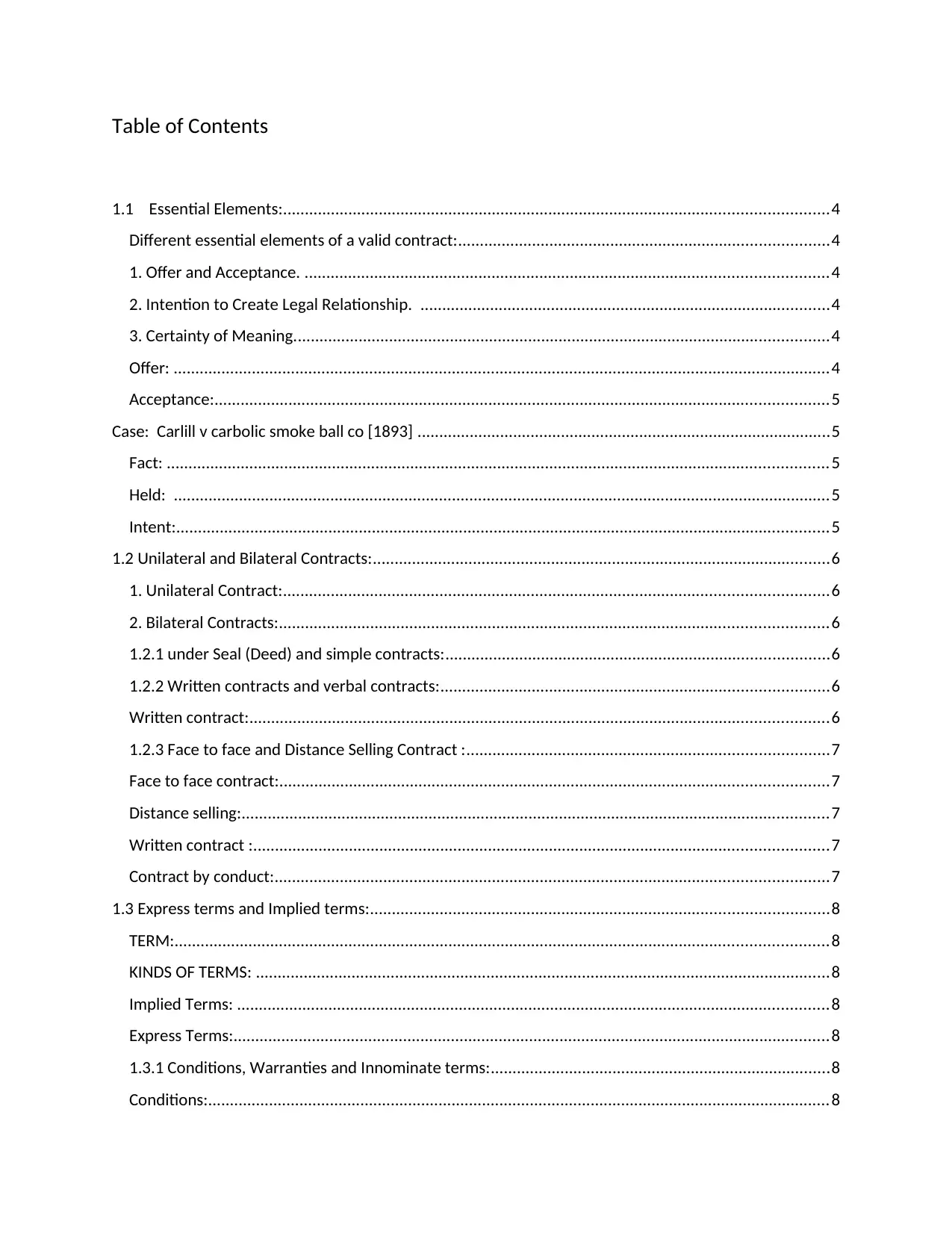
Table of Contents
1.1 Essential Elements:.............................................................................................................................4
Different essential elements of a valid contract:.....................................................................................4
1. Offer and Acceptance. ........................................................................................................................4
2. Intention to Create Legal Relationship. ..............................................................................................4
3. Certainty of Meaning...........................................................................................................................4
Offer: .......................................................................................................................................................4
Acceptance:.............................................................................................................................................5
Case: Carlill v carbolic smoke ball co [1893] ...............................................................................................5
Fact: ........................................................................................................................................................5
Held: .......................................................................................................................................................5
Intent:......................................................................................................................................................5
1.2 Unilateral and Bilateral Contracts:.........................................................................................................6
1. Unilateral Contract:.............................................................................................................................6
2. Bilateral Contracts:..............................................................................................................................6
1.2.1 under Seal (Deed) and simple contracts:........................................................................................6
1.2.2 Written contracts and verbal contracts:.........................................................................................6
Written contract:.....................................................................................................................................6
1.2.3 Face to face and Distance Selling Contract :...................................................................................7
Face to face contract:..............................................................................................................................7
Distance selling:.......................................................................................................................................7
Written contract :....................................................................................................................................7
Contract by conduct:...............................................................................................................................7
1.3 Express terms and Implied terms:.........................................................................................................8
TERM:......................................................................................................................................................8
KINDS OF TERMS: ....................................................................................................................................8
Implied Terms: ........................................................................................................................................8
Express Terms:.........................................................................................................................................8
1.3.1 Conditions, Warranties and Innominate terms:..............................................................................8
Conditions:...............................................................................................................................................8
1.1 Essential Elements:.............................................................................................................................4
Different essential elements of a valid contract:.....................................................................................4
1. Offer and Acceptance. ........................................................................................................................4
2. Intention to Create Legal Relationship. ..............................................................................................4
3. Certainty of Meaning...........................................................................................................................4
Offer: .......................................................................................................................................................4
Acceptance:.............................................................................................................................................5
Case: Carlill v carbolic smoke ball co [1893] ...............................................................................................5
Fact: ........................................................................................................................................................5
Held: .......................................................................................................................................................5
Intent:......................................................................................................................................................5
1.2 Unilateral and Bilateral Contracts:.........................................................................................................6
1. Unilateral Contract:.............................................................................................................................6
2. Bilateral Contracts:..............................................................................................................................6
1.2.1 under Seal (Deed) and simple contracts:........................................................................................6
1.2.2 Written contracts and verbal contracts:.........................................................................................6
Written contract:.....................................................................................................................................6
1.2.3 Face to face and Distance Selling Contract :...................................................................................7
Face to face contract:..............................................................................................................................7
Distance selling:.......................................................................................................................................7
Written contract :....................................................................................................................................7
Contract by conduct:...............................................................................................................................7
1.3 Express terms and Implied terms:.........................................................................................................8
TERM:......................................................................................................................................................8
KINDS OF TERMS: ....................................................................................................................................8
Implied Terms: ........................................................................................................................................8
Express Terms:.........................................................................................................................................8
1.3.1 Conditions, Warranties and Innominate terms:..............................................................................8
Conditions:...............................................................................................................................................8
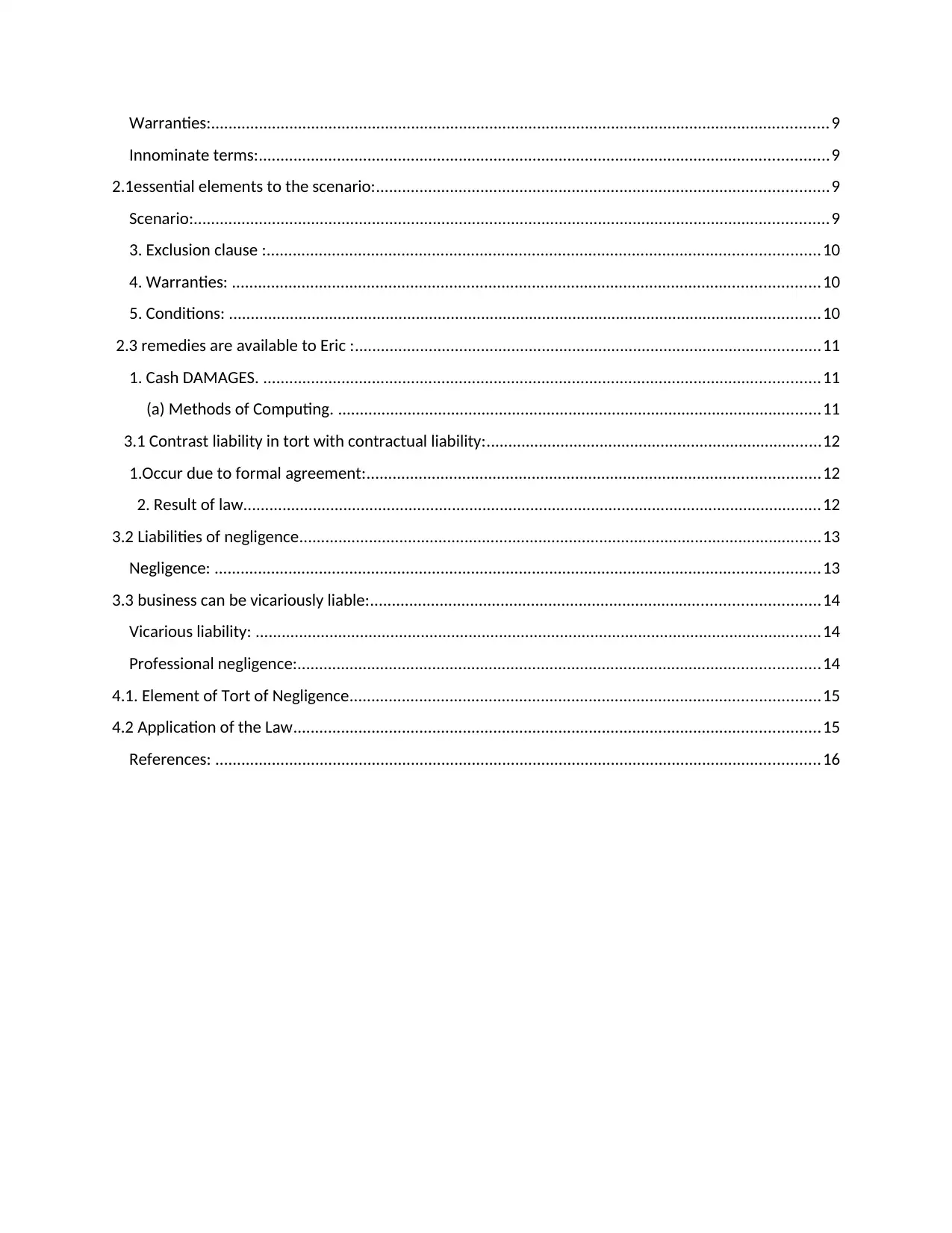
Warranties:..............................................................................................................................................9
Innominate terms:...................................................................................................................................9
2.1essential elements to the scenario:........................................................................................................9
Scenario:..................................................................................................................................................9
3. Exclusion clause :...............................................................................................................................10
4. Warranties: .......................................................................................................................................10
5. Conditions: ........................................................................................................................................10
2.3 remedies are available to Eric :...........................................................................................................11
1. Cash DAMAGES. ................................................................................................................................11
(a) Methods of Computing. ...............................................................................................................11
3.1 Contrast liability in tort with contractual liability:.............................................................................12
1.Occur due to formal agreement:........................................................................................................12
2. Result of law.....................................................................................................................................12
3.2 Liabilities of negligence........................................................................................................................13
Negligence: ...........................................................................................................................................13
3.3 business can be vicariously liable:.......................................................................................................14
Vicarious liability: ..................................................................................................................................14
Professional negligence:........................................................................................................................14
4.1. Element of Tort of Negligence............................................................................................................15
4.2 Application of the Law.........................................................................................................................15
References: ...........................................................................................................................................16
Innominate terms:...................................................................................................................................9
2.1essential elements to the scenario:........................................................................................................9
Scenario:..................................................................................................................................................9
3. Exclusion clause :...............................................................................................................................10
4. Warranties: .......................................................................................................................................10
5. Conditions: ........................................................................................................................................10
2.3 remedies are available to Eric :...........................................................................................................11
1. Cash DAMAGES. ................................................................................................................................11
(a) Methods of Computing. ...............................................................................................................11
3.1 Contrast liability in tort with contractual liability:.............................................................................12
1.Occur due to formal agreement:........................................................................................................12
2. Result of law.....................................................................................................................................12
3.2 Liabilities of negligence........................................................................................................................13
Negligence: ...........................................................................................................................................13
3.3 business can be vicariously liable:.......................................................................................................14
Vicarious liability: ..................................................................................................................................14
Professional negligence:........................................................................................................................14
4.1. Element of Tort of Negligence............................................................................................................15
4.2 Application of the Law.........................................................................................................................15
References: ...........................................................................................................................................16
⊘ This is a preview!⊘
Do you want full access?
Subscribe today to unlock all pages.

Trusted by 1+ million students worldwide
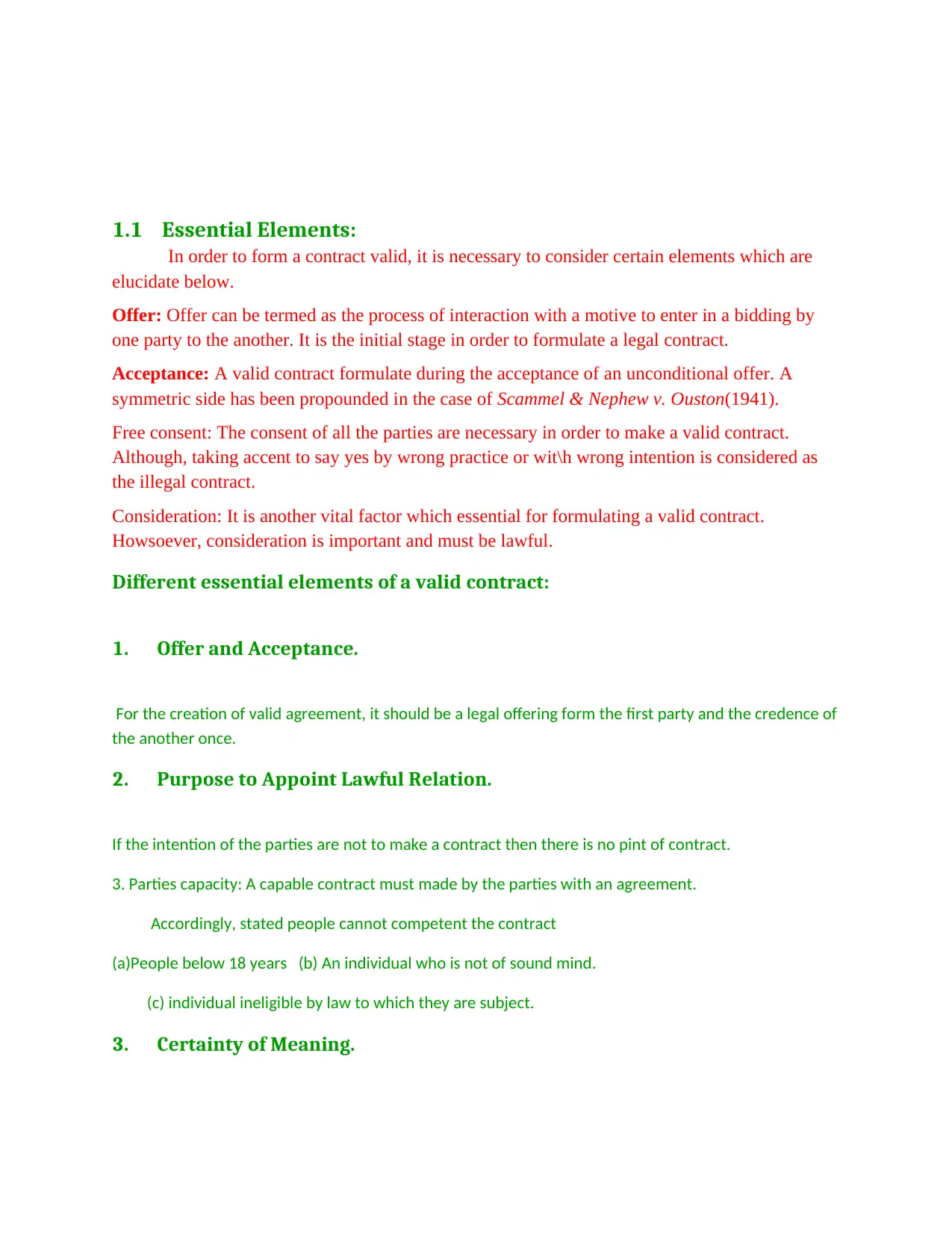
1.1 Essential Elements:
In order to form a contract valid, it is necessary to consider certain elements which are
elucidate below.
Offer: Offer can be termed as the process of interaction with a motive to enter in a bidding by
one party to the another. It is the initial stage in order to formulate a legal contract.
Acceptance: A valid contract formulate during the acceptance of an unconditional offer. A
symmetric side has been propounded in the case of Scammel & Nephew v. Ouston(1941).
Free consent: The consent of all the parties are necessary in order to make a valid contract.
Although, taking accent to say yes by wrong practice or wit\h wrong intention is considered as
the illegal contract.
Consideration: It is another vital factor which essential for formulating a valid contract.
Howsoever, consideration is important and must be lawful.
Different essential elements of a valid contract:
1. Offer and Acceptance.
For the creation of valid agreement, it should be a legal offering form the first party and the credence of
the another once.
2. Purpose to Appoint Lawful Relation.
If the intention of the parties are not to make a contract then there is no pint of contract.
3. Parties capacity: A capable contract must made by the parties with an agreement.
Accordingly, stated people cannot competent the contract
(a)People below 18 years (b) An individual who is not of sound mind.
(c) individual ineligible by law to which they are subject.
3. Certainty of Meaning.
In order to form a contract valid, it is necessary to consider certain elements which are
elucidate below.
Offer: Offer can be termed as the process of interaction with a motive to enter in a bidding by
one party to the another. It is the initial stage in order to formulate a legal contract.
Acceptance: A valid contract formulate during the acceptance of an unconditional offer. A
symmetric side has been propounded in the case of Scammel & Nephew v. Ouston(1941).
Free consent: The consent of all the parties are necessary in order to make a valid contract.
Although, taking accent to say yes by wrong practice or wit\h wrong intention is considered as
the illegal contract.
Consideration: It is another vital factor which essential for formulating a valid contract.
Howsoever, consideration is important and must be lawful.
Different essential elements of a valid contract:
1. Offer and Acceptance.
For the creation of valid agreement, it should be a legal offering form the first party and the credence of
the another once.
2. Purpose to Appoint Lawful Relation.
If the intention of the parties are not to make a contract then there is no pint of contract.
3. Parties capacity: A capable contract must made by the parties with an agreement.
Accordingly, stated people cannot competent the contract
(a)People below 18 years (b) An individual who is not of sound mind.
(c) individual ineligible by law to which they are subject.
3. Certainty of Meaning.
Paraphrase This Document
Need a fresh take? Get an instant paraphrase of this document with our AI Paraphraser
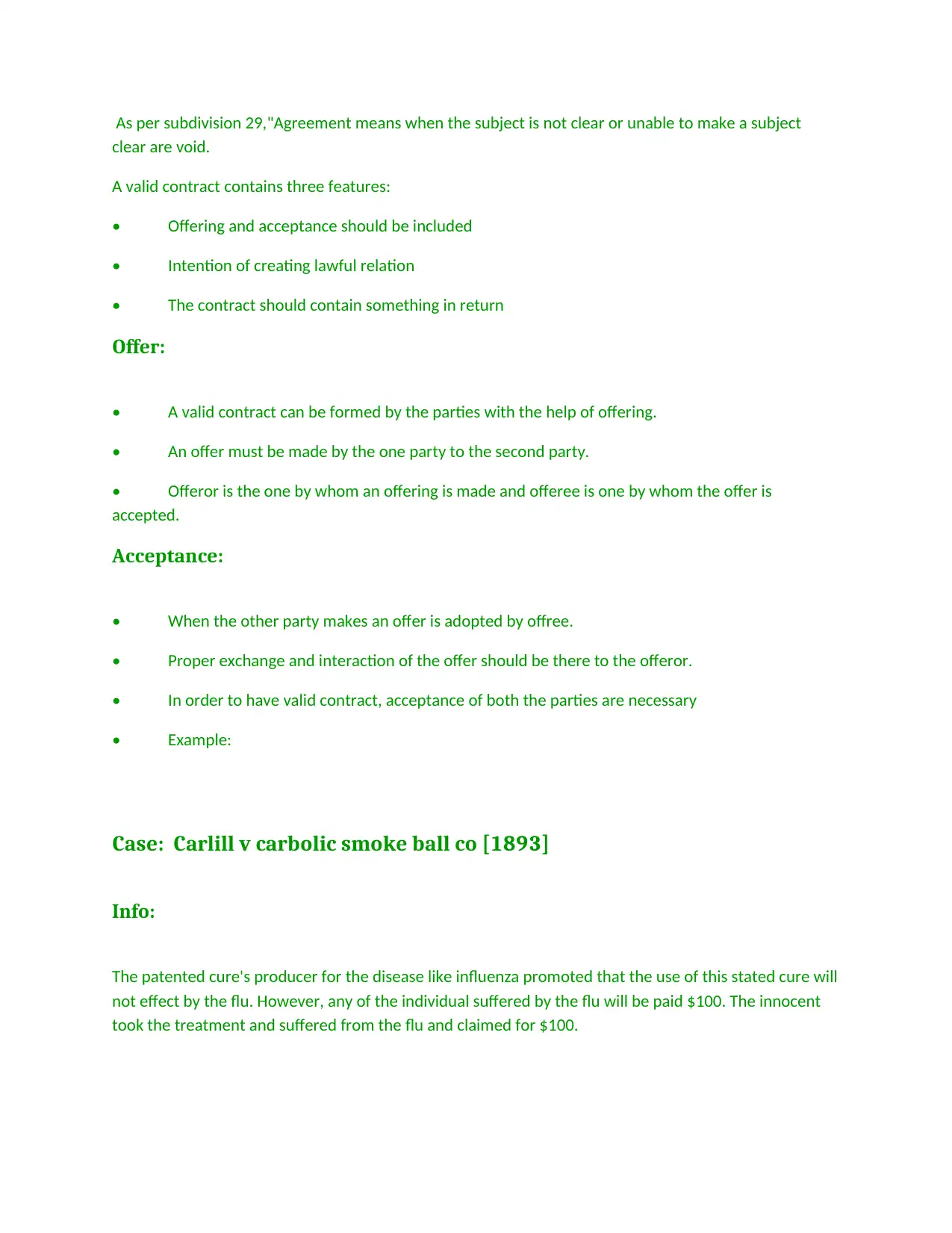
As per subdivision 29,"Agreement means when the subject is not clear or unable to make a subject
clear are void.
A valid contract contains three features:
• Offering and acceptance should be included
• Intention of creating lawful relation
• The contract should contain something in return
Offer:
• A valid contract can be formed by the parties with the help of offering.
• An offer must be made by the one party to the second party.
• Offeror is the one by whom an offering is made and offeree is one by whom the offer is
accepted.
Acceptance:
• When the other party makes an offer is adopted by offree.
• Proper exchange and interaction of the offer should be there to the offeror.
• In order to have valid contract, acceptance of both the parties are necessary
• Example:
Case: Carlill v carbolic smoke ball co [1893]
Info:
The patented cure's producer for the disease like influenza promoted that the use of this stated cure will
not effect by the flu. However, any of the individual suffered by the flu will be paid $100. The innocent
took the treatment and suffered from the flu and claimed for $100.
clear are void.
A valid contract contains three features:
• Offering and acceptance should be included
• Intention of creating lawful relation
• The contract should contain something in return
Offer:
• A valid contract can be formed by the parties with the help of offering.
• An offer must be made by the one party to the second party.
• Offeror is the one by whom an offering is made and offeree is one by whom the offer is
accepted.
Acceptance:
• When the other party makes an offer is adopted by offree.
• Proper exchange and interaction of the offer should be there to the offeror.
• In order to have valid contract, acceptance of both the parties are necessary
• Example:
Case: Carlill v carbolic smoke ball co [1893]
Info:
The patented cure's producer for the disease like influenza promoted that the use of this stated cure will
not effect by the flu. However, any of the individual suffered by the flu will be paid $100. The innocent
took the treatment and suffered from the flu and claimed for $100.
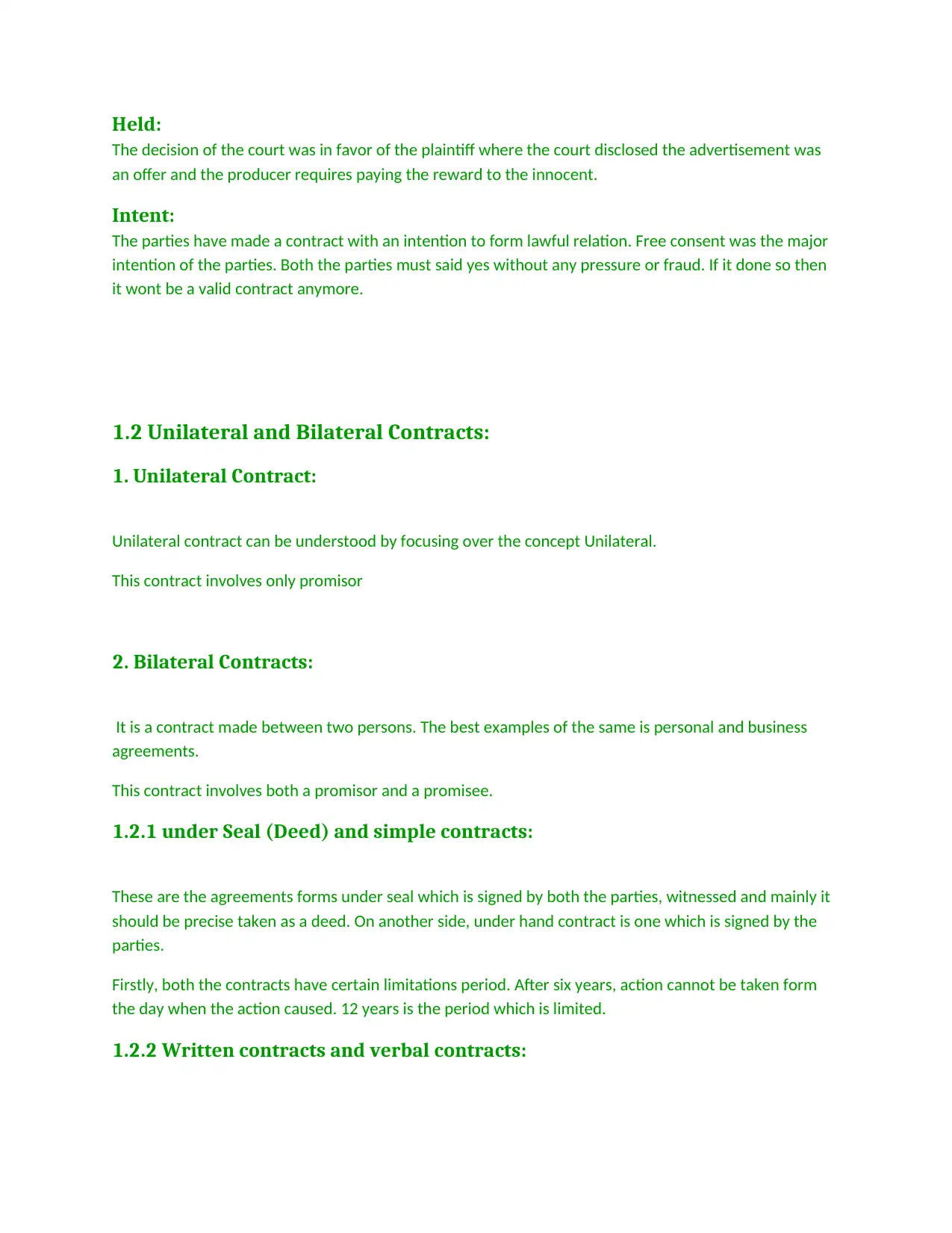
Held:
The decision of the court was in favor of the plaintiff where the court disclosed the advertisement was
an offer and the producer requires paying the reward to the innocent.
Intent:
The parties have made a contract with an intention to form lawful relation. Free consent was the major
intention of the parties. Both the parties must said yes without any pressure or fraud. If it done so then
it wont be a valid contract anymore.
1.2 Unilateral and Bilateral Contracts:
1. Unilateral Contract:
Unilateral contract can be understood by focusing over the concept Unilateral.
This contract involves only promisor
2. Bilateral Contracts:
It is a contract made between two persons. The best examples of the same is personal and business
agreements.
This contract involves both a promisor and a promisee.
1.2.1 under Seal (Deed) and simple contracts:
These are the agreements forms under seal which is signed by both the parties, witnessed and mainly it
should be precise taken as a deed. On another side, under hand contract is one which is signed by the
parties.
Firstly, both the contracts have certain limitations period. After six years, action cannot be taken form
the day when the action caused. 12 years is the period which is limited.
1.2.2 Written contracts and verbal contracts:
The decision of the court was in favor of the plaintiff where the court disclosed the advertisement was
an offer and the producer requires paying the reward to the innocent.
Intent:
The parties have made a contract with an intention to form lawful relation. Free consent was the major
intention of the parties. Both the parties must said yes without any pressure or fraud. If it done so then
it wont be a valid contract anymore.
1.2 Unilateral and Bilateral Contracts:
1. Unilateral Contract:
Unilateral contract can be understood by focusing over the concept Unilateral.
This contract involves only promisor
2. Bilateral Contracts:
It is a contract made between two persons. The best examples of the same is personal and business
agreements.
This contract involves both a promisor and a promisee.
1.2.1 under Seal (Deed) and simple contracts:
These are the agreements forms under seal which is signed by both the parties, witnessed and mainly it
should be precise taken as a deed. On another side, under hand contract is one which is signed by the
parties.
Firstly, both the contracts have certain limitations period. After six years, action cannot be taken form
the day when the action caused. 12 years is the period which is limited.
1.2.2 Written contracts and verbal contracts:
⊘ This is a preview!⊘
Do you want full access?
Subscribe today to unlock all pages.

Trusted by 1+ million students worldwide
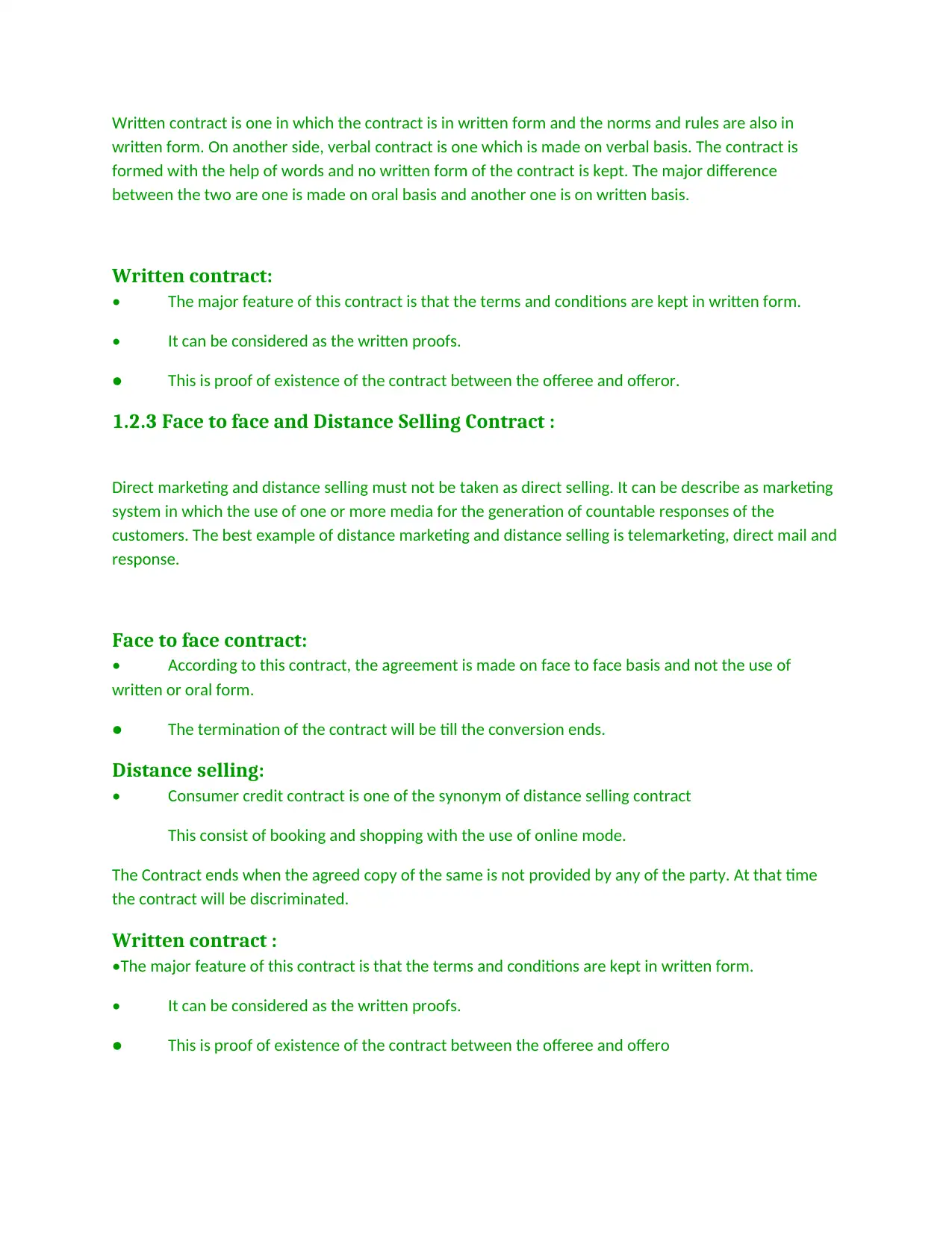
Written contract is one in which the contract is in written form and the norms and rules are also in
written form. On another side, verbal contract is one which is made on verbal basis. The contract is
formed with the help of words and no written form of the contract is kept. The major difference
between the two are one is made on oral basis and another one is on written basis.
Written contract:
• The major feature of this contract is that the terms and conditions are kept in written form.
• It can be considered as the written proofs.
● This is proof of existence of the contract between the offeree and offeror.
1.2.3 Face to face and Distance Selling Contract :
Direct marketing and distance selling must not be taken as direct selling. It can be describe as marketing
system in which the use of one or more media for the generation of countable responses of the
customers. The best example of distance marketing and distance selling is telemarketing, direct mail and
response.
Face to face contract:
• According to this contract, the agreement is made on face to face basis and not the use of
written or oral form.
● The termination of the contract will be till the conversion ends.
Distance selling:
• Consumer credit contract is one of the synonym of distance selling contract
This consist of booking and shopping with the use of online mode.
The Contract ends when the agreed copy of the same is not provided by any of the party. At that time
the contract will be discriminated.
Written contract :
•The major feature of this contract is that the terms and conditions are kept in written form.
• It can be considered as the written proofs.
● This is proof of existence of the contract between the offeree and offero
written form. On another side, verbal contract is one which is made on verbal basis. The contract is
formed with the help of words and no written form of the contract is kept. The major difference
between the two are one is made on oral basis and another one is on written basis.
Written contract:
• The major feature of this contract is that the terms and conditions are kept in written form.
• It can be considered as the written proofs.
● This is proof of existence of the contract between the offeree and offeror.
1.2.3 Face to face and Distance Selling Contract :
Direct marketing and distance selling must not be taken as direct selling. It can be describe as marketing
system in which the use of one or more media for the generation of countable responses of the
customers. The best example of distance marketing and distance selling is telemarketing, direct mail and
response.
Face to face contract:
• According to this contract, the agreement is made on face to face basis and not the use of
written or oral form.
● The termination of the contract will be till the conversion ends.
Distance selling:
• Consumer credit contract is one of the synonym of distance selling contract
This consist of booking and shopping with the use of online mode.
The Contract ends when the agreed copy of the same is not provided by any of the party. At that time
the contract will be discriminated.
Written contract :
•The major feature of this contract is that the terms and conditions are kept in written form.
• It can be considered as the written proofs.
● This is proof of existence of the contract between the offeree and offero
Paraphrase This Document
Need a fresh take? Get an instant paraphrase of this document with our AI Paraphraser
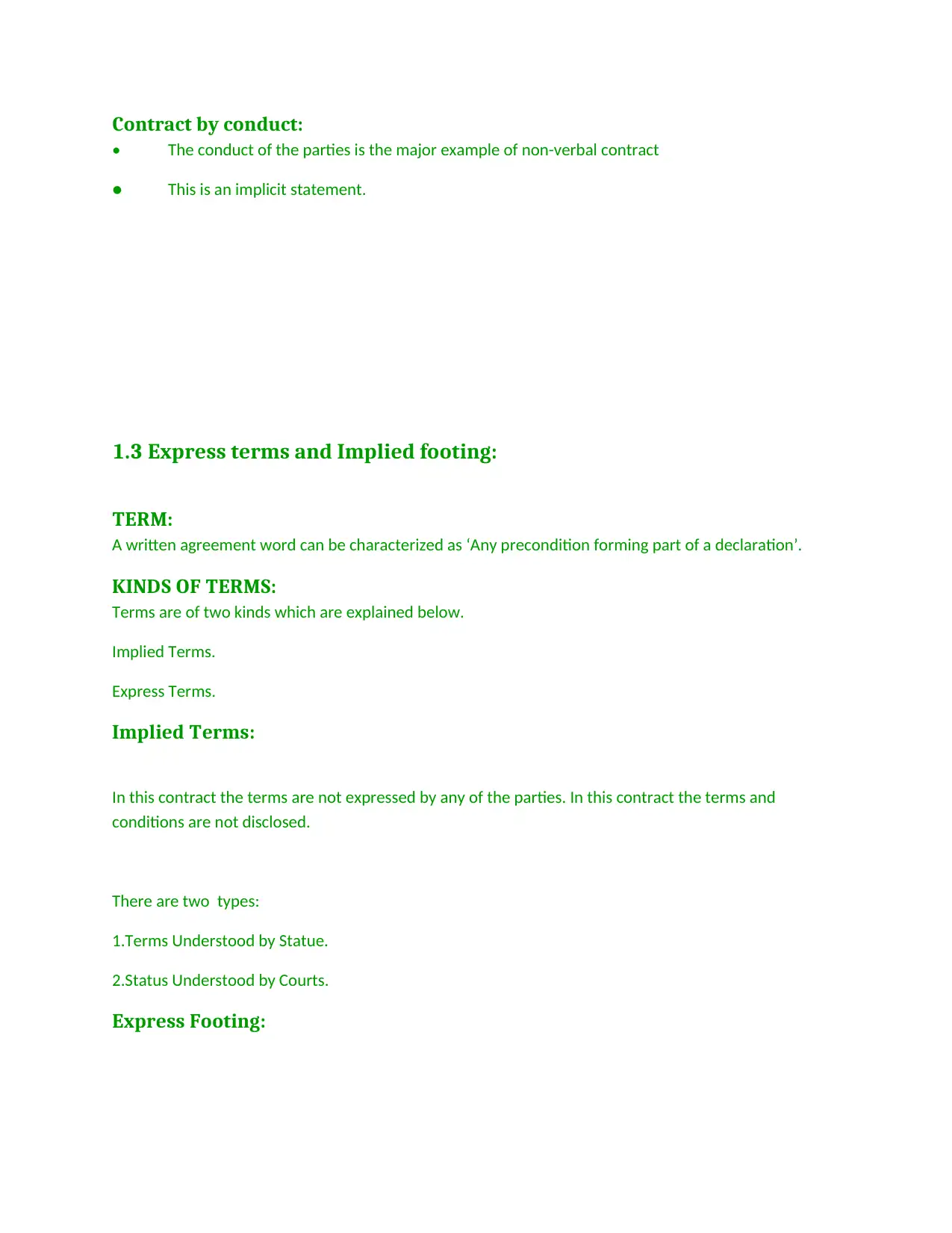
Contract by conduct:
• The conduct of the parties is the major example of non-verbal contract
● This is an implicit statement.
1.3 Express terms and Implied footing:
TERM:
A written agreement word can be characterized as ‘Any precondition forming part of a declaration’.
KINDS OF TERMS:
Terms are of two kinds which are explained below.
Implied Terms.
Express Terms.
Implied Terms:
In this contract the terms are not expressed by any of the parties. In this contract the terms and
conditions are not disclosed.
There are two types:
1.Terms Understood by Statue.
2.Status Understood by Courts.
Express Footing:
• The conduct of the parties is the major example of non-verbal contract
● This is an implicit statement.
1.3 Express terms and Implied footing:
TERM:
A written agreement word can be characterized as ‘Any precondition forming part of a declaration’.
KINDS OF TERMS:
Terms are of two kinds which are explained below.
Implied Terms.
Express Terms.
Implied Terms:
In this contract the terms are not expressed by any of the parties. In this contract the terms and
conditions are not disclosed.
There are two types:
1.Terms Understood by Statue.
2.Status Understood by Courts.
Express Footing:

The expressed contract is one where both the parties expresses their views and agree on the common
things. This contract may be in written or oral form.
1.3.1 Conditions, Warranties and Innominate terms:
Conditions:
A stipulation is a leading word of the written agreement which goes to the base of the bid. If a status is
failure the exculpated party is eligible to renounce (end) the written agreement and assertion amends.
Warranties:
Assurance are insignificant footing of a written agreement which are not fundamental to the being of
the contract. If a assurance is rupture the guiltless party may assertion damages but cannot ending the
declaration.
Innominate terms:
The innominate word formulation was constituted in the lawsuit of Hong Kong Fir Cargo ships. Instead
of assort the position themselves as conditions or warranties, the innominate term formulation
expression to the consequence of the failure and inquiry.
2.1 M2 Essential elements to the scenario:
Scenario
A unilateral contract is being initiate by the City Car Dealer with a motive to render the
circumstances and facts. For the same, an advertisement is being published in the newspaper
giving a car as a prize. However, the organization has bounded themselves with the term of
contract. With the help of this information, Abel commit himself to go to the city mountain for
collecting ticket and aback to the showroom in the defined time i.e. 3 hours. Although, as the as
task is being completed by Abel, all the individual will become a part of bilateral contract with
the aforesaid firm. Further, the dealer of said firm has denied to continue the contract said and
made by the firm.
On the basis of presented facts and figures, it can be stated that the management of City
Car Dealers have breached the contract by not providing the cars according to mentioned in the
newspaper advertisement. As a result, all the winners of the contract are enforceable to go to the
court. The same act was seen in the case of Carllil v. Carbolic Smoke Ball Company (1892),
things. This contract may be in written or oral form.
1.3.1 Conditions, Warranties and Innominate terms:
Conditions:
A stipulation is a leading word of the written agreement which goes to the base of the bid. If a status is
failure the exculpated party is eligible to renounce (end) the written agreement and assertion amends.
Warranties:
Assurance are insignificant footing of a written agreement which are not fundamental to the being of
the contract. If a assurance is rupture the guiltless party may assertion damages but cannot ending the
declaration.
Innominate terms:
The innominate word formulation was constituted in the lawsuit of Hong Kong Fir Cargo ships. Instead
of assort the position themselves as conditions or warranties, the innominate term formulation
expression to the consequence of the failure and inquiry.
2.1 M2 Essential elements to the scenario:
Scenario
A unilateral contract is being initiate by the City Car Dealer with a motive to render the
circumstances and facts. For the same, an advertisement is being published in the newspaper
giving a car as a prize. However, the organization has bounded themselves with the term of
contract. With the help of this information, Abel commit himself to go to the city mountain for
collecting ticket and aback to the showroom in the defined time i.e. 3 hours. Although, as the as
task is being completed by Abel, all the individual will become a part of bilateral contract with
the aforesaid firm. Further, the dealer of said firm has denied to continue the contract said and
made by the firm.
On the basis of presented facts and figures, it can be stated that the management of City
Car Dealers have breached the contract by not providing the cars according to mentioned in the
newspaper advertisement. As a result, all the winners of the contract are enforceable to go to the
court. The same act was seen in the case of Carllil v. Carbolic Smoke Ball Company (1892),
⊘ This is a preview!⊘
Do you want full access?
Subscribe today to unlock all pages.

Trusted by 1+ million students worldwide
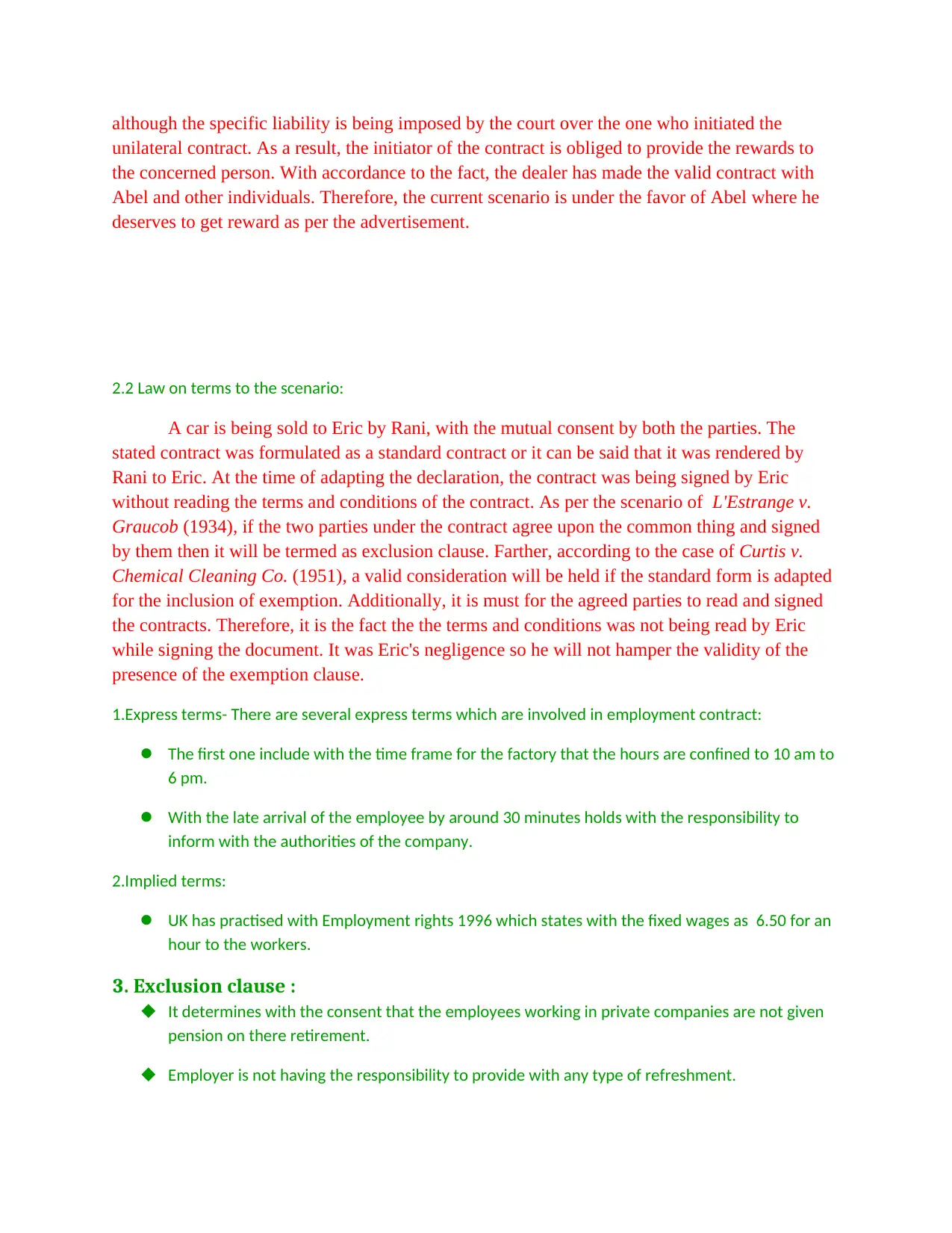
although the specific liability is being imposed by the court over the one who initiated the
unilateral contract. As a result, the initiator of the contract is obliged to provide the rewards to
the concerned person. With accordance to the fact, the dealer has made the valid contract with
Abel and other individuals. Therefore, the current scenario is under the favor of Abel where he
deserves to get reward as per the advertisement.
2.2 Law on terms to the scenario:
A car is being sold to Eric by Rani, with the mutual consent by both the parties. The
stated contract was formulated as a standard contract or it can be said that it was rendered by
Rani to Eric. At the time of adapting the declaration, the contract was being signed by Eric
without reading the terms and conditions of the contract. As per the scenario of L'Estrange v.
Graucob (1934), if the two parties under the contract agree upon the common thing and signed
by them then it will be termed as exclusion clause. Farther, according to the case of Curtis v.
Chemical Cleaning Co. (1951), a valid consideration will be held if the standard form is adapted
for the inclusion of exemption. Additionally, it is must for the agreed parties to read and signed
the contracts. Therefore, it is the fact the the terms and conditions was not being read by Eric
while signing the document. It was Eric's negligence so he will not hamper the validity of the
presence of the exemption clause.
1.Express terms- There are several express terms which are involved in employment contract:
The first one include with the time frame for the factory that the hours are confined to 10 am to
6 pm.
With the late arrival of the employee by around 30 minutes holds with the responsibility to
inform with the authorities of the company.
2.Implied terms:
UK has practised with Employment rights 1996 which states with the fixed wages as 6.50 for an
hour to the workers.
3. Exclusion clause :
It determines with the consent that the employees working in private companies are not given
pension on there retirement.
Employer is not having the responsibility to provide with any type of refreshment.
unilateral contract. As a result, the initiator of the contract is obliged to provide the rewards to
the concerned person. With accordance to the fact, the dealer has made the valid contract with
Abel and other individuals. Therefore, the current scenario is under the favor of Abel where he
deserves to get reward as per the advertisement.
2.2 Law on terms to the scenario:
A car is being sold to Eric by Rani, with the mutual consent by both the parties. The
stated contract was formulated as a standard contract or it can be said that it was rendered by
Rani to Eric. At the time of adapting the declaration, the contract was being signed by Eric
without reading the terms and conditions of the contract. As per the scenario of L'Estrange v.
Graucob (1934), if the two parties under the contract agree upon the common thing and signed
by them then it will be termed as exclusion clause. Farther, according to the case of Curtis v.
Chemical Cleaning Co. (1951), a valid consideration will be held if the standard form is adapted
for the inclusion of exemption. Additionally, it is must for the agreed parties to read and signed
the contracts. Therefore, it is the fact the the terms and conditions was not being read by Eric
while signing the document. It was Eric's negligence so he will not hamper the validity of the
presence of the exemption clause.
1.Express terms- There are several express terms which are involved in employment contract:
The first one include with the time frame for the factory that the hours are confined to 10 am to
6 pm.
With the late arrival of the employee by around 30 minutes holds with the responsibility to
inform with the authorities of the company.
2.Implied terms:
UK has practised with Employment rights 1996 which states with the fixed wages as 6.50 for an
hour to the workers.
3. Exclusion clause :
It determines with the consent that the employees working in private companies are not given
pension on there retirement.
Employer is not having the responsibility to provide with any type of refreshment.
Paraphrase This Document
Need a fresh take? Get an instant paraphrase of this document with our AI Paraphraser
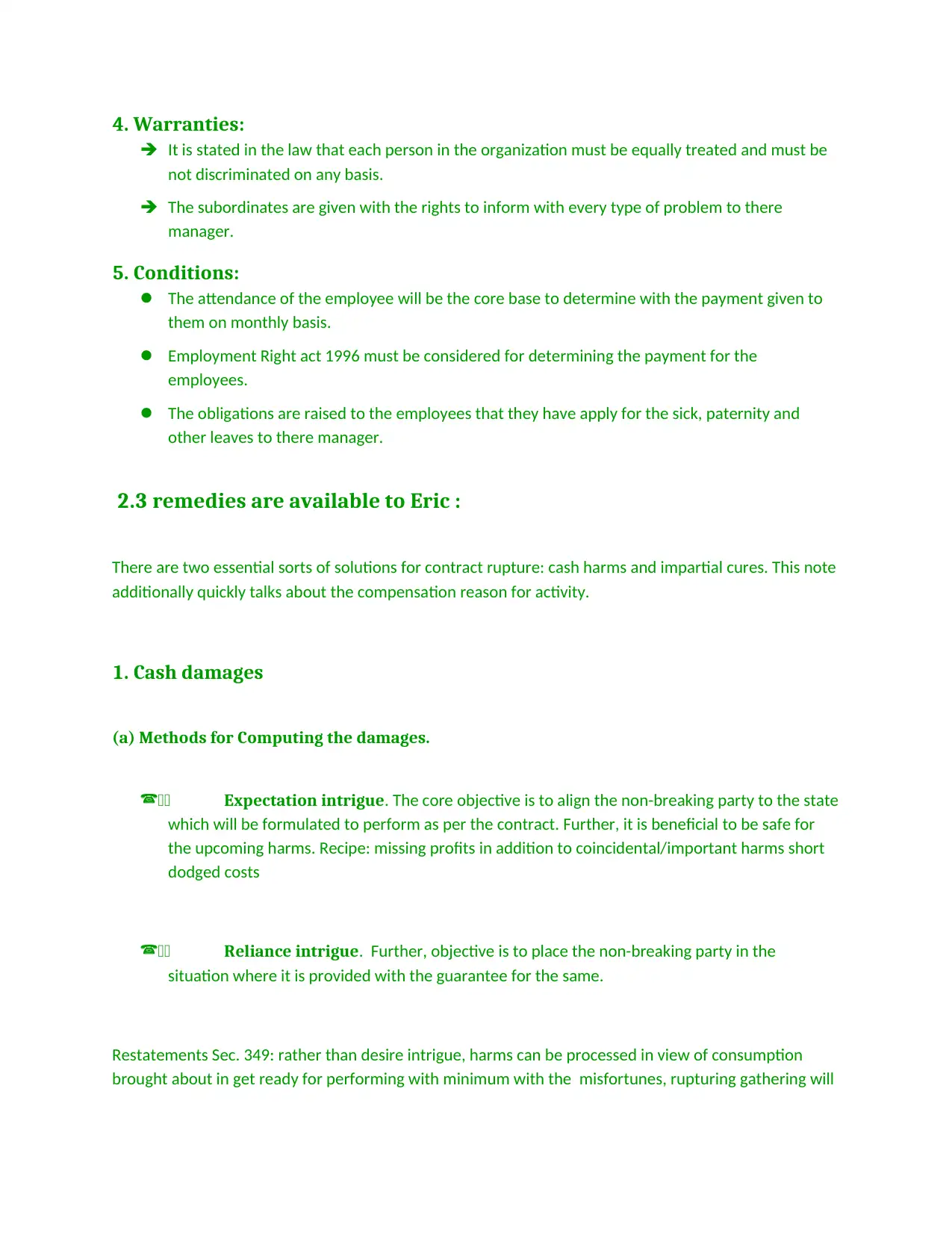
4. Warranties:
It is stated in the law that each person in the organization must be equally treated and must be
not discriminated on any basis.
The subordinates are given with the rights to inform with every type of problem to there
manager.
5. Conditions:
The attendance of the employee will be the core base to determine with the payment given to
them on monthly basis.
Employment Right act 1996 must be considered for determining the payment for the
employees.
The obligations are raised to the employees that they have apply for the sick, paternity and
other leaves to there manager.
2.3 remedies are available to Eric :
There are two essential sorts of solutions for contract rupture: cash harms and impartial cures. This note
additionally quickly talks about the compensation reason for activity.
1. Cash damages
(a) Methods for Computing the damages.
(11 Expectation intrigue. The core objective is to align the non-breaking party to the state
which will be formulated to perform as per the contract. Further, it is beneficial to be safe for
the upcoming harms. Recipe: missing profits in addition to coincidental/important harms short
dodged costs
(11 Reliance intrigue. Further, objective is to place the non-breaking party in the
situation where it is provided with the guarantee for the same.
Restatements Sec. 349: rather than desire intrigue, harms can be processed in view of consumption
brought about in get ready for performing with minimum with the misfortunes, rupturing gathering will
It is stated in the law that each person in the organization must be equally treated and must be
not discriminated on any basis.
The subordinates are given with the rights to inform with every type of problem to there
manager.
5. Conditions:
The attendance of the employee will be the core base to determine with the payment given to
them on monthly basis.
Employment Right act 1996 must be considered for determining the payment for the
employees.
The obligations are raised to the employees that they have apply for the sick, paternity and
other leaves to there manager.
2.3 remedies are available to Eric :
There are two essential sorts of solutions for contract rupture: cash harms and impartial cures. This note
additionally quickly talks about the compensation reason for activity.
1. Cash damages
(a) Methods for Computing the damages.
(11 Expectation intrigue. The core objective is to align the non-breaking party to the state
which will be formulated to perform as per the contract. Further, it is beneficial to be safe for
the upcoming harms. Recipe: missing profits in addition to coincidental/important harms short
dodged costs
(11 Reliance intrigue. Further, objective is to place the non-breaking party in the
situation where it is provided with the guarantee for the same.
Restatements Sec. 349: rather than desire intrigue, harms can be processed in view of consumption
brought about in get ready for performing with minimum with the misfortunes, rupturing gathering will
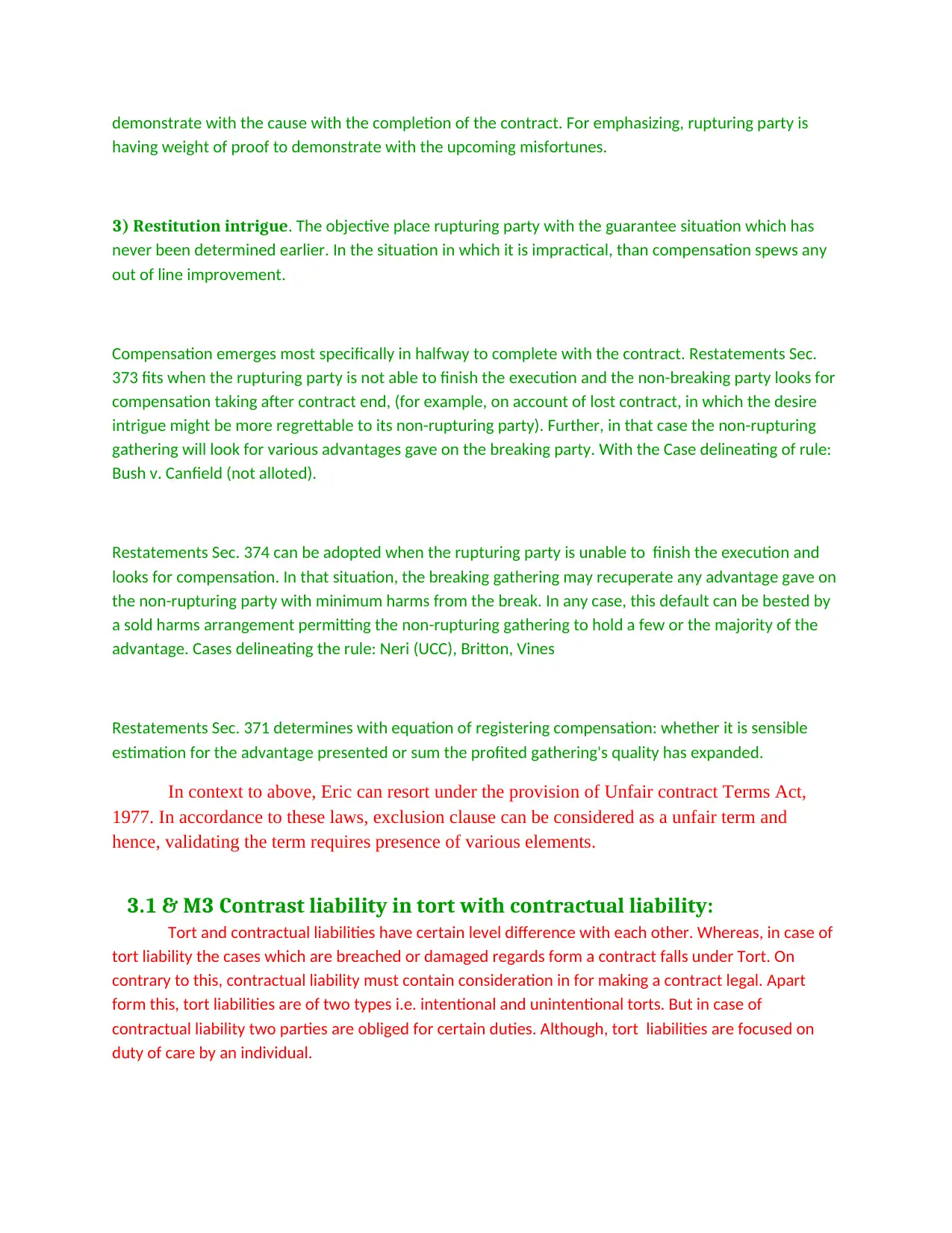
demonstrate with the cause with the completion of the contract. For emphasizing, rupturing party is
having weight of proof to demonstrate with the upcoming misfortunes.
3) Restitution intrigue. The objective place rupturing party with the guarantee situation which has
never been determined earlier. In the situation in which it is impractical, than compensation spews any
out of line improvement.
Compensation emerges most specifically in halfway to complete with the contract. Restatements Sec.
373 fits when the rupturing party is not able to finish the execution and the non-breaking party looks for
compensation taking after contract end, (for example, on account of lost contract, in which the desire
intrigue might be more regrettable to its non-rupturing party). Further, in that case the non-rupturing
gathering will look for various advantages gave on the breaking party. With the Case delineating of rule:
Bush v. Canfield (not alloted).
Restatements Sec. 374 can be adopted when the rupturing party is unable to finish the execution and
looks for compensation. In that situation, the breaking gathering may recuperate any advantage gave on
the non-rupturing party with minimum harms from the break. In any case, this default can be bested by
a sold harms arrangement permitting the non-rupturing gathering to hold a few or the majority of the
advantage. Cases delineating the rule: Neri (UCC), Britton, Vines
Restatements Sec. 371 determines with equation of registering compensation: whether it is sensible
estimation for the advantage presented or sum the profited gathering's quality has expanded.
In context to above, Eric can resort under the provision of Unfair contract Terms Act,
1977. In accordance to these laws, exclusion clause can be considered as a unfair term and
hence, validating the term requires presence of various elements.
3.1 & M3 Contrast liability in tort with contractual liability:
Tort and contractual liabilities have certain level difference with each other. Whereas, in case of
tort liability the cases which are breached or damaged regards form a contract falls under Tort. On
contrary to this, contractual liability must contain consideration in for making a contract legal. Apart
form this, tort liabilities are of two types i.e. intentional and unintentional torts. But in case of
contractual liability two parties are obliged for certain duties. Although, tort liabilities are focused on
duty of care by an individual.
having weight of proof to demonstrate with the upcoming misfortunes.
3) Restitution intrigue. The objective place rupturing party with the guarantee situation which has
never been determined earlier. In the situation in which it is impractical, than compensation spews any
out of line improvement.
Compensation emerges most specifically in halfway to complete with the contract. Restatements Sec.
373 fits when the rupturing party is not able to finish the execution and the non-breaking party looks for
compensation taking after contract end, (for example, on account of lost contract, in which the desire
intrigue might be more regrettable to its non-rupturing party). Further, in that case the non-rupturing
gathering will look for various advantages gave on the breaking party. With the Case delineating of rule:
Bush v. Canfield (not alloted).
Restatements Sec. 374 can be adopted when the rupturing party is unable to finish the execution and
looks for compensation. In that situation, the breaking gathering may recuperate any advantage gave on
the non-rupturing party with minimum harms from the break. In any case, this default can be bested by
a sold harms arrangement permitting the non-rupturing gathering to hold a few or the majority of the
advantage. Cases delineating the rule: Neri (UCC), Britton, Vines
Restatements Sec. 371 determines with equation of registering compensation: whether it is sensible
estimation for the advantage presented or sum the profited gathering's quality has expanded.
In context to above, Eric can resort under the provision of Unfair contract Terms Act,
1977. In accordance to these laws, exclusion clause can be considered as a unfair term and
hence, validating the term requires presence of various elements.
3.1 & M3 Contrast liability in tort with contractual liability:
Tort and contractual liabilities have certain level difference with each other. Whereas, in case of
tort liability the cases which are breached or damaged regards form a contract falls under Tort. On
contrary to this, contractual liability must contain consideration in for making a contract legal. Apart
form this, tort liabilities are of two types i.e. intentional and unintentional torts. But in case of
contractual liability two parties are obliged for certain duties. Although, tort liabilities are focused on
duty of care by an individual.
⊘ This is a preview!⊘
Do you want full access?
Subscribe today to unlock all pages.

Trusted by 1+ million students worldwide
1 out of 17
Related Documents
Your All-in-One AI-Powered Toolkit for Academic Success.
+13062052269
info@desklib.com
Available 24*7 on WhatsApp / Email
![[object Object]](/_next/static/media/star-bottom.7253800d.svg)
Unlock your academic potential
Copyright © 2020–2025 A2Z Services. All Rights Reserved. Developed and managed by ZUCOL.





